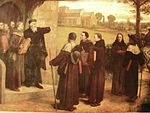Tanchelm

Tanchelm (approx. 1070 - Antwerp, 1115), also known as Tanchelm of Antwerp, Tanchelijn, Tanquelin or Tanchelin, was an itinerant preacher critical of the established Roman Catholic church, active in the Low Countries around the beginning of the 12th century.
History[edit]
Tanchelm was supposed to have been a monk, perhaps from the circle of Count Robert II of Flanders (1092–1111). From 1112 he preached in Antwerp, the Duchy of Brabant, Flanders and Zeeland against the official church and its hierarchy, against the Real Presence in the Eucharist. He opposed the payment of tithes and condemned those priests who lived with women.
He was apparently also in Rome, where he is supposed to have campaigned, in vain, for an extension of the Bishopric of Thérouanne to cover the islands of the Scheldt. He was briefly put under arrest in Cologne in 1113–1114 but released again, despite the vigorous protests of the cathedral clergy of Utrecht. In 1115, he was slain by a priest while on a water journey.[1]
The followers of Tanchelm, who is reported to have allowed himself to be venerated almost to the point of worship,[citation needed] were still to be found for a period after his death in Antwerp; in 1124 Saint Norbert of Xanten preached against them.
Tanchelm prefigured ideas in the Protestant reformation.[2]
Controversy about his views[edit]
The negative information regarding Tanchelm has been contained in no more than two documents:
- a letter written by canons of the cathedral of Utrecht,
- a postmortem memorandum written by followers of saint Norbert.
As both these documents were written by enemies of Tanchelm and no contradictory documents have emerged, professor Henri Pirenne put question marks behind the accusations and formulated another thesis.
He theorized that Tanchelm was a collaborator of the count of Flanders and, like his master, took sides with the Pope regarding the investiture controversy. By acting so, he was declared an enemy by the bishop and the canons of Utrecht, who had taken sides with the Holy Roman Emperor. Hence the fierce opposition and the slanderous accusations against him and, in the end, his assassination.
References[edit]
- ^ Jacob Cornelis van Slee (1894), "Tanchelm", Allgemeine Deutsche Biographie (in German), vol. 37, Leipzig: Duncker & Humblot, pp. 364–365
- ^ Reddy, Mike Megrove (2017). "The forms of communication employed by the Protestant Reformers and especially Luther and Calvin" (PDF). Pharos Journal of Theology. 98.
The Pre-Reformers: All groups that spoke out against the church were regarded as "heretical" groups. In the same light, the present-day church considers those individuals that questioned the church "doctrine" and "teachings" as heretics. McCallum (2002:n.p.) states that there were eight heretical groups of pre-reformers between the 12th and 15th centuries during the various European regions. McCallum 2002:n.p. mentions them as follows:
- Flagellants were in 1259. They marched with only loincloths through the streets crying out to God to show mercy on them (McCallum 2002:n.p.). In 1349 they were condemned.
- Then there was a variety of lay groups known as Beguines who had no specific set of forms (McCallum, 2002;n.p.). They were followers of Lambert le Begue who was a stammerer.
- In the 12th century Tanchelm preached in the diocese of Utrecht. He denied the author of the pope and the church and attacked the structure of the Catholic Church (McCallum, 2002:n.p.).
- Peter of Bruys in the 12th century also rejected christening of infants. He rejected prayers for the dead, the Eucharist veneration of the cross and ecclesiastical ceremonies (McCallum, 2002:n.p.).
- In the first half of 12th century Henry of Lausanne preached in what is known as France. His followers were known as the Henricans. The clergy were condemned for the love of wealth and power by Henry of Lausanne (McCallum, 2002:n.p.).
- The Adamists engaged in behaviour that was socially unacceptable and indulged in the practice of nude worship.
- Arnold of Brescia wanted the church to follow Christian ideals (McCallum 2002:n.p.). He attacked the bishops for their dishonest gains. He was hanged in 1155 and his body was burned.
- The Pataria, in Northern Italy were in reaction to the corruption which was taking place in the church. McCallum (2002:n.p.) states that the self-indulgent practices within the Roman Catholic Church were also opposed by other smaller movements.
Sources[edit]
- Henri PIRENNE, Tanchelin et le projet de démembrement du diocèse d'Utrecht vers 1100, in: Bulletin des Classes des lettres et des sciences morales et politiques de l'Académie royale de Belgique, 1927.
- Beulertz, S. (ed. ) 1999: Tanchelm, in: Lexikon des Mittelalters, vol. 8, col. 455. Stuttgart-Weimar
- Cohn, Norman 1958: The Pursuit of the Millennium: Revolutionary Millenarism and Mystical Anarchists of the Middle Ages. Secker & Warburg.
External links[edit]
- . Encyclopedia Americana. 1920.

